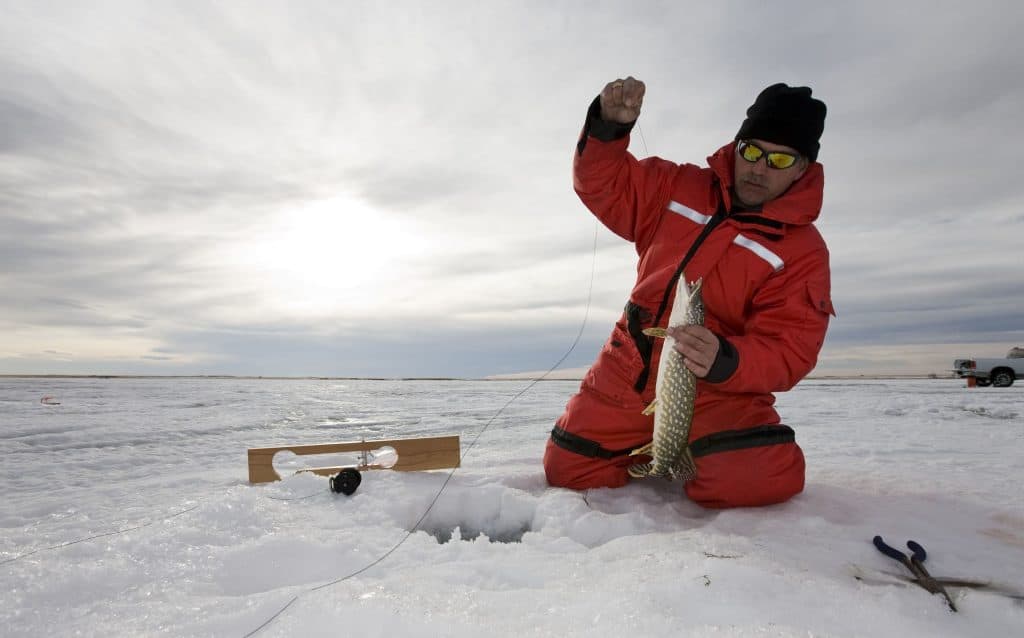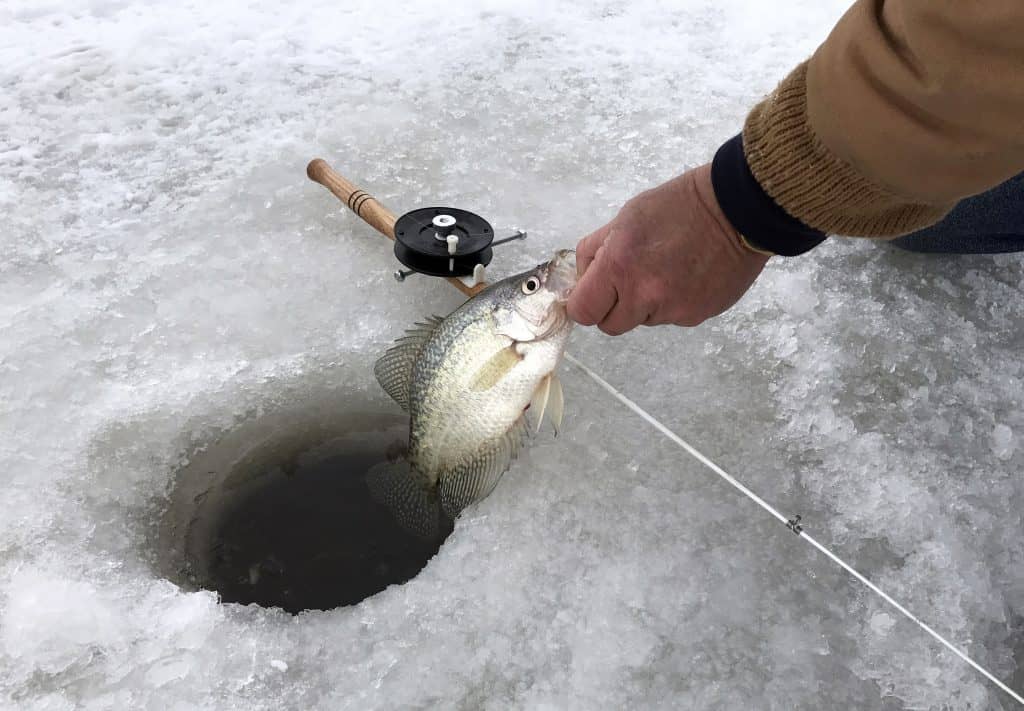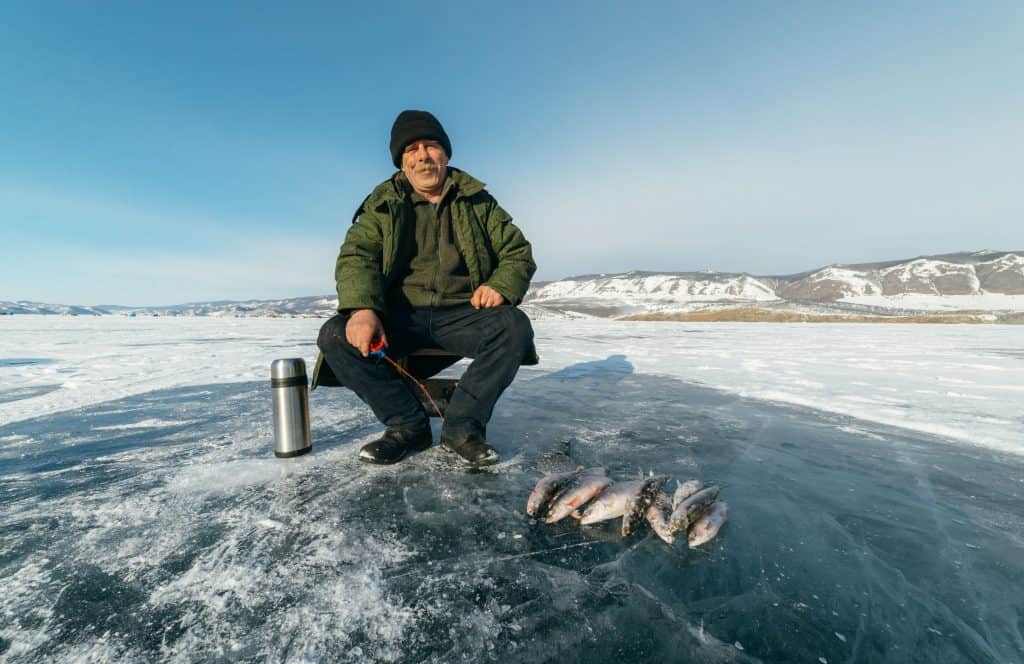There are two main ways to catch fish in ice fishing: tip-ups and poles. Which one is better? I’m going to list fifteen pros and cons to help you decide which tools you should use.

1. With Tip-Ups Freezing Holes Are Less of a Problem
Because ice fishing is often done in freezing temperatures, the holes you dig tend to freeze over after a while. This is no huge problem, as long as you have something to break the newly formed ice.
However, tip-ups have a big advantage in this situation. Because the spool they use is underwater, well below the level where the thin ice will form, it won’t freeze. If a fish takes the bait, the tip-up will work as usual and send its flag up.
With a rod, though, if you were to let the ice form solid, you might find that since your line gets frozen in place, a fish could take your bait without you even noticing. So you really need to always keep breaking the ice, which is not hard but is just kind of a pain.
You will still need to break the ice once the flag does go off if you plan to actually bring the fish up, but even just grabbing the tip-up and pulling it up will probably do that, unless the ice has been freezing for a very long time.
For extra cold days, tip-ups have this great advantage.
2. Tip-Ups Give the Fish More Time to Escape
With a normal fishing rod, you most likely are keeping it in your hands, ready to reel a fish in when you feel it tugging.
With a tip-up, you will never be as quick to start bringing the fish to the surface (unless you constantly sit right next to it, which pretty much defeats the purpose). You will be waiting until you notice the flag up, and once you see it, you go and pull the fish up.
But that’s assuming the fish didn’t get lucky and escape while you were walking over there. Sure, this usually won’t happen, but with a tip-up, you are leaving a bit more to chance than with a pole.
With normal rods, you can start reeling in the fish the moment it bites. You are ready for the battle from the moment it begins. So, that definitely gives you an advantage in that aspect.
3. Tip-Ups Let You Test Different Waters at the Same Time
Tip-ups let you cover far more ground than having just one fishing pole. You can dig holes in many different spots on the ice and put a tip-up on each one.
The advantage of that is clear. You don’t know exactly where the most fish are, but by trying different spots, you can figure it out. And because you can try many spots at the same time, it’s way more efficient than trying one spot at a time.
Are there more fish in deep waters or shallow? Although an experienced fisherman may have a good idea about where they are likely to be before even digging any holes, it never hurts to try different regions of the ice.
4. Tip-Ups Can Make For a More Relaxing Fishing Trip
Some fishermen are serious about catching as many fish as possible. Other people may just want to go ice fishing to relax and socialize with friends and family.
If you are particularly interested in just relaxing and chatting with friends while still hopefully bringing home some fish, tip-ups are great for that. Just set one up and wait for the flag to go up.
Hopefully, you can find a good spot where fish bite, because you don’t want to be too bored. While your traps are set, you should be able to have a great, relaxing time just socializing, not having to focus too much on attracting fish. Then when a flag goes up, you can enjoy pulling in the fish.
If you’re content to just have a relaxing time on the frozen water, tip-ups can definitely help with that.

5. Jigging Attracts Fish Better Than Using Tip-Ups
A tip-up has really only one way of attracting fish: dangling it in front of them. It can’t move the bait around to better attract them.
Many ice fishermen will tell you that it’s more effective to use jigs to catch the fishes’ attention.
It’s easy to understand that a lot of fish are going to be more interested in bait that moves like it’s alive than if something is just sitting there. That’s what jigging does. A fisherman moves the rod around, which causes the jig to move in a jerky, quick motion.
A tip-up simply can’t offer the sort of appeal to fish that someone jigging can. Sure, fish will often lazily go for bait that’s just floating there, but a jig can greatly increase your chance of success.
For that reason, serious fishermen will often use fishing poles with jigs when ice fishing. Many use these in combination with tip-ups, of course.
6. Tip-Ups Are a More Passive Approach
Using a regular fishing pole with a jig is an active approach to fishing that can result in great success. On the other hand, setting a tip-up and waiting for a fish to take a bite of the bait that’s suspended underwater is a much more passive approach.
Some will not like this sort of passiveness. They would rather be actively doing something to ensure that fish get caught.
If no flags go off, you might find yourself just sitting there bored, wondering if you need to move all your tip-ups. Also, you might get especially cold due to the lack of activity.
A pole is not a guarantee to success, of course, but some people would rather be a little more active when fishing, so the pole is definitely the right choice for them.
Of course, it would be even wiser for such a person to use a combination of poles and tip-ups if they can afford to take the time to set them up because that will only increase the chances of catching lots of fish.
7. Tip-Ups Take Longer to Set Up
Ice fishing always takes a bit more preparation than other fishing before your line can go in the water due to the fact that you have to dig a hole through the ice, but once you do that, setting up a fishing pole is the same as any other kind of fishing.
Setting up a tip-up, though, can take a bit longer. Even if you already have enough line on the spool, extending that line so that it goes down to the depth you desire will take longer than using a pole, which generally has a design that will allow you to release a lot of your line quickly.
There are some tip-up designs that may mitigate this issue, but in general, poles are just a bit quicker.
8. A Group of Tip-Ups Can Trap Many Fish At Once
Many states have regulations on how many lines you can put in the water at a time, but regardless of how many are allowed, more is better than fewer.
If you are able to place several tip-ups at one time, that means the possibility of hooking several fish at once exists.
Imagine seeing a flag go up and pulling a fish out of the water, only to notice another flag go up nearby. This sort of fishing feels effortless, and it can be a lot of fun.
If you’re only going to use a single pole, you can only catch fish one after the other. This is great too, of course, but there is definitely a high level of efficiency in being able to have several fish hooked at once, and all you have to do is to go pull them out of the water.
Using tip-ups can be the faster way to catch lots of fish, in this way, if you’ve picked a good spot to place them.
9. Running From Tip-Up to Tip-Up Can Be Fun
Many fans of ice fishing find it quite fun to place a bunch of tip-ups in different spots and later run around from tip-up to tip-up pulling in fish after fish. This can’t happen if the fish aren’t biting, of course.
If the fish are biting, what could be more fun than staying busy just pulling in fish? It’s especially fun if you have friends with you. You can split up the work: one friend can go to a certain tip-up, another can go to another. Or you can just run around together.
All that running is good exercise, too. I said earlier that if the fish don’t bite, you might get cold from just sitting there, but if the fish do bite, and bite a lot at that, you might end up sweating.
There’s no guarantee that you will experience this sort of fun, but I say that tip-ups are worth a try because of the chance of this happening. Few things feel better than being busy and successful.
10. Poles are More Mobile
Sometimes fishermen want to move from spot to spot quickly. Poles have the advantage of this. It is quicker to reel in your line and walk off, pole already in hand, to the next spot than it is to pick up a tip-up, pull up the line by hand (this will take a while if you sent it down deep) and then head out.
This is not a huge blow against tip-ups, but some ice fishermen definitely like to be as quick as they can be, and if poles make it easier for them to do that, then poles are what they should use.

11. Fighting a Fish Is Easier With a Pole
There is a difference between the two tools when it comes to bringing the hooked fish to the surface. Rods tend to have reels where you turn the handle to bring in the line. Tip-ups tend to not have those.
So, when a tip-up has hooked something, your best option is to pull the line out of the water by hand. This is why choosing good line is important.
Meanwhile, when using a pole with a reel, you really just need to turn the handle to bring the fish towards you. This is less work than with the tip-up.
When trying to bring in a fish who’s fighting against you, you may be glad you chose to use a pole, as it’s just a bit easier than pulling the line by hand. Physics are on your side when you have a strong pole to bear some of the force of the struggle. It’s a battle that can be won with or without a pole, but the pole could give a fisherman the edge.
12. Poles Are Easier to Find
While tip-ups are a common tool for ice fishing, fishing rods are sold in more stores and during all seasons. There are rods that are better suited for ice fishing than others, naturally, but there is a wide variety of options that will work.
To be more direct, there are ice rods made specifically for ice fishing, but normal fishing rods can work for ice fishing too.
Online shopping makes either tool pretty easy to find, and sometimes you can find free shipping. But certainly, if you are looking to buy from a physical store, you will find it easier to find options if you look for a pole.
The reason for that is pretty simple: fishing in warm weather is more popular than ice fishing, and tip-ups are not useful unless there’s ice.
13. Tip-Ups Are Inexpensive
The price of fishing rods can vary depending on the type of quality you are looking for. Overall, the barrier of entry is actually rather affordable.
However, tip-ups are even less costly than fishing poles. This is a nice benefit, and potentially a good way to save a few bucks.
The bad news is that whichever you use, you’re going to have to get tools to cut a hole in the ice and possibly to carry all your gear, so ice fishing is certainly not the cheapest kind of fishing you can get into.
If you already have a fishing rod and want to use tip-ups to increase your efficiency, the low cost of obtaining them will be perfect for you. That way, you get the best of both worlds, increasing your productivity by spending just a few extra bucks.
14. Tip-Ups Make It Easier For People to Prank You
This is a funny aspect of using tip-ups. A situation can arise where you’re inside your shelter and you have some tip-ups set outside. A person nearby can say, “Your flag is up,” and then, of course, you’ll look outside your window or door, only to find that they were just messing with you.
Pretty good joke, right? Well, if you ask me, that’s actually not that funny, but it just depends on what you like.
Hopefully, you are a fan of that sort of leg-pulling. If not, then I advise not using tip-ups. But then again, people will always find ways to mess with each other.
15. Tip-Ups Aren’t Useful For Other Kinds of Fishing
There are fishing rods made specifically for ice fishing you may want to buy, but it’s certainly not an absolute requirement. Normal fishing rods will work too. If you have a fishing pole already and don’t want to get a different one for ice fishing, you’ll be able to fish just fine. You might even say you’re getting more for your money that way.
Tip-ups, though, are not so versatile. You obtain them for ice fishing and probably don’t use them for anything else.
After all, the situation of needing to dangle a fishing line deep into a hole from an object that rests on top of the edges of that hole probably does not come up too often.
Should that stop you from using tip-ups? I don’t think so. There are many specialized tools out there that are only good at one thing, and that’s normal. Besides, tip-ups aren’t expensive.
It may seem lame, when you compare tip-ups to normal fishing rods, that tip-ups can’t be used all year, but tip-ups are very useful and perform a specific job that nothing else does so perfectly. So, yes, their lack of versatility is a con, but not one that should keep you from seeing their usefulness.
So there you have it 15 Pros and Cons of Poles and Tip-ups. Find what works for you and keep fishing!
